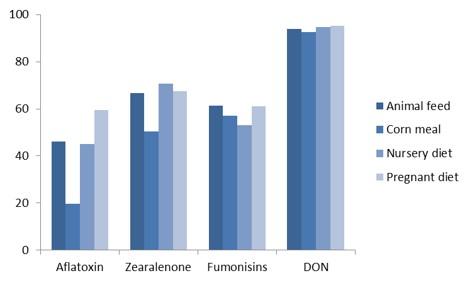
Content sponsored by:
Life Rainbow
Annual survey of mycotoxin in feed in 2017-Taiwan
Published: July 10, 2018
By: Life Rainbow Biotech
In 2017, 493 randomly collected feed samples of raw materials and feed mills in farms were analyzed. Samples were tested for aflatoxins (B1, B2, G1, and G2), zearalenone, fumonisins (B1, B2, and B3) and deoxynivalenol by the ELISA Mycotoxin analysis kit (Romer Labs®).
Results
Of 493 feed samples collected, 93.9% were contaminated with deoxynivalenol (table 1). All the maximum concentrations of mycotoxin were over the limit of quantification in this survey.

Data on corn meal, nursery, and pregnant diet were conducted to give the prevalence of mycotoxins. Out of total 493 samples, 107 samples from corn meal were analyzed that observed 92.5% of feed were contaminated with deoxynivalenol (table 2).

Of 113 samples of nursery feed collected, 94.7% of samples were contaminated with deoxynivalenol (table 3). The occurrence of mycotoxin in pregnant diet also analyzed. In addition to the highly contamination rate with deoxynivalenol, both Zearalenone and fumonisins were detected more than 60% of all tested samples (table 4).


In 2017, the most prevalent mycotoxin in Taiwan is deoxynivalenol detected more than 90% in both raw materials and finished feeds (Figure 1.). In addition, fumonisins, zearalenone, and deoxynivalenol have higher average contamination levels compared to last two years. This may reveal the influence on corps by climatic condition in different imported region in this year. Co-contamination was also observed in this survey. Occurrence with more than one mycotoxin may give synergistic complications on animal performance and immunity that cause financial loss of producers.

Figure 1. Occurrence (%) of mycotoxin in different diet.
Conclusion:
Presentation and distribution of mycotoxins is related to variation of temperature or humidity, pest biting, the storage condition, and etc. Most of the mycotoxins were developing in the field than in the storage or during mixing. Mycotoxin contaminated feedstuffs will raise the risk to impact animal production and economic profit. Understanding the occurrence of mycotoxins will help to implement solutions to mycotoxin management in farms. The potential synergistic effect of multiple mycotoxin contamination was also predictable from this annual report. According to the reginal report, other than indicating a monitoring procedure, feed manufacturers and animal producers can also be aware of the risk of sourcing raw materials and take the actions of remedy.
Related topics:
Recommend
Comment
Share
26 de julio de 2018
When we talk about permissible level of mycotoxins, I have experienced that it varies from breed to breed and even from animal to animal. In that case, we should consider all the factors influencing variability of results while designing a study.
Recommend
Reply
25 de julio de 2018
Drying food products using natural/artificial resources soon at harvest followed my moisture-proof storage (Dry Chain) and using such raw material in feeds could lower the contaminations documented in this quite informative study. Use of food crops resistant/tolerant to storage mold infections should also be encouraged.
Recommend
Reply

Would you like to discuss another topic? Create a new post to engage with experts in the community.


.jpg&w=3840&q=75)